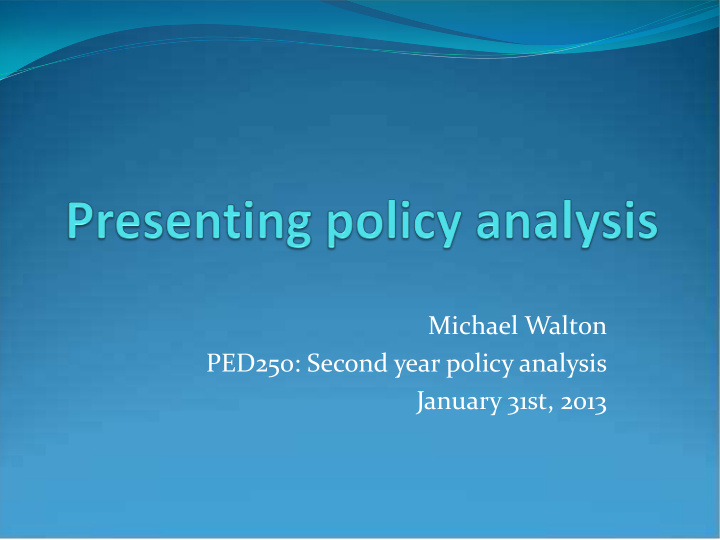



Michael Walton PED250: Second year policy analysis January 31st, 2013
Messages In most professional settings, good work will be ineffective without good presentation, writing and orally Persuasive presentation is not a gift, but a craft that can be learned It’s about both Substance: presenting material Style: your physical presence
Today’s presentation Presentation – substance Presentation – style Handling questions and follow up
Presentation: substance There are many ways of presenting effectively Anecdote plus analysis: NYT Shock, story and surprise Blink + classical The safest is blink + classical Immediate message Adjusted sonata form: message, development, recapitulation/implications
Presentation: substance Organize around messages Main message--in one sentence Subsidiary and supporting messages Evidence: how best to convey? Graphs Text Tables Refer to model-driven analysis where needed to convince audience messages are sound, conceptually and empirically
Presentation: substance Powerpoints You don’t have to use them! But graphs and possibly tables are important Avoid too much text; use a large font; use titles for messages Use simple figures, e.g. flowcharts, if they tell the story as well as text Review and update the overview slide Most common mistakes: too much material on individual slides and too many slides Average 2 minutes per slide!
Presentation: substance Presenting evidence Doing it well for the written paper can save a lot of time for a presentation —you can cut and paste good graphs Loads of books on presenting data. Luci Herman session next week Some tips…
Presenting data to influence.. Don’t Present piles of detailed tables Construct overly fancy graphs Cut and paste econometric results Do Lead the reader with the title Highlight key results For presentations graphs should pass the 3 second (blink) test
There is enormous variation in the incidence of programs, from very pro-rich to very pro-poor Concentration coefficients measure how progressive or regressive is spending Progressive (pro-poor) Regressive (pro-rich)
Tables Have a descriptive title that conveys your message. Put your “favorite variable” in a prominent position Use asterisks to indicate significance levels Think about suppressing covariates Make the table itself tell the story Put into convenient terms ( not absolutes ).
Explaining results—make it intelligible “Regression coefficient of civil liberties in explaining project performance is .08 and statistically significant” versus “A country moving from the level of civil liberties of Zaire to that of Costa Rica could expect to see project performance increase 16 percentage points” “the coefficient of agency commitment to beneficiary participation is .42” versus “Increasing agency commitment from low levels to high levels has the same impact as the project having no spare parts to all spare parts being available”
Presenting Analytical Results (e.g. theory and modeling) Present a figure with the complete conceptual model Be able to give a graphic interpretation Be able to give intuition, an example
Graphical illustration of complex relations
Presentation: style Most of the impact of a presentation derives from your physical presence, not the substance!
Presentation: style Take command of the space and audience Eye contact Body movement The opening is key Manage the material, don’t let the material manage you If you use powerpoint, think where you want the audience to look Don’t read the powerpoint!
Presentation: style Feel the energy level in the room, adjust if necessary Prepare the ending--be prepared to jump to it if time runs out For a high profile/stressful presentation ….relax for a few minutes before starting ….have a drink after ending
Presentation: style Miscellaneous tips Don’t apologize Don’t turn your back on the audience Don’t over-stay your welcome If timing matters and the meeting is crucial, do a practice run Be prepared for technology failure
Managing questions Engaged and respectful, but clear It’s not (usually) a debating context Taking questions in groups works in many contexts Address concerns , which may involve answering questions Manage the questioners with big egos (don’t let them get to you, perhaps stroke them a bit, and don’t let them take over) Pay attention to the decision makers you need to persuade
…final thoughts It’s not about you! The best presenters are deeply engaged in conveying their material, not themselves TED http://www.ted.com/ has good (and not so good) examples
…additional resources from the Shorenstein center http://shorensteincenter.org/students/communications- program/communications-workshops/ Handouts from presentations will be available at http://shorensteincenter.org/students/communications- program/writing-public-speaking-handouts/ The Shorenstein center will also provide individual support.
Conclusions If your work was worth doing, it is worth presenting well Anyone can be an effective presenter—but it takes time and thought….see the King’s Speech! Make use of your SYPA presentations to learn about presenting
Recommend
More recommend